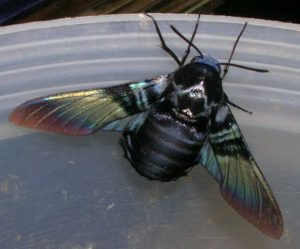Mumbai: In her profession, she is known as a lepidopterist, a person who collects or studies butteflies or moths. And she is one plucky woman who strays into dangerous territory without any qualms to pursue her hobby-turned-obsession – chasing and studying moths, or nocturnal butterflies.

The equipment includes a light trap and a white bedsheet, a 165 watt generator-mounted mercury lamp. The bedsheet is stretched between trees and the lamp hung above it. This attracts a large number of moths, enabling her to take notes and pictures.
A pioneer among the handful of women in the field, Shubhalaxmi’s passion paid off handsomely – she has recorded 419 moth species in Maharashtra and 500 in Arunachal Pradesh (more about the state later) in the past 10 years.
In 2005, she even discovered the Carpenter Bee Hawkmoth in the Sanjay Gandhi National Park (SGNP) here that was hitherto found only in Myanmar, and frolicked with the Atlas Moth, the world’s largest moth with a wing span of over 12 inches that is also found in the Park.
Acknowledged as India’s first woman lepidopterist studying the most elusive and shy, and least studied insect on the Indian sub-continent, it is difficult to imagine that in her younger days, Shubhalaxmi had a phobia for any insect.
“My mother also suffered from it, so probably it was inherited! However, my love for nature was too overpowering and I wanted a prefix of doctor before my name, so I plunged into the field,” Shubhalaxmi laughed.
An encounter with insects at the Bombay Natural History Society (BNHS) virtually rid her of the fear of these fliers and crawlers and she actually started loving them.
When she focussed on her chosen field – butterflies and moths – she was surprised to find that after the British rule, not much effort was made to study or record them; nor were any experts in the field available in the country, barring a few researchers.

“I could not identify it and there were no available records in the volumes compiled by British entomologists. I went to the Arunachal Pradesh wilds for 10 days and nights. Though that particular moth still eluded me, over time, I was able to document nearly 500 moth species,” said Shubhalaxmi in an interview.
That was the start of her regular forays into the rough and tough wilds, forests, hills and mountains, huge open fields, barren lands and even deserts to chase moths.
In fact, her guide for her masters and doctoral studies, the late Naresh Chaturvedi, a former BNHS curator, flatly warned her that she would have to carry out primary field research as there was absolutely no reference material on moths in the country.
At present, there are around 127,000 species of moths recorded in the world and there are an estimated 12,000 in India – and the field was wide open with little or no competition.
Shubhalaxmi started with the SGNP in 1993. Located in the Borivli suburb of northwest Mumbai and spread across nearly 104 sq km, the Park is considered the world’s only wildlife reserve within an urban landscape.
“The forest officials were surprised and amused to see me, then around 21, walking in a forest full of leopards, snakes and other night animals. Helped by my driver and an assistant from BNHS, I would put up a screen and arc-lights to attract the moths for the next two years,” she said.
Though at times she wandered off into the thick wilderness, most of the time she would patiently wait and watch and study the moths amidst the cacophony of other nocturnal insects, crawlies and animals as the SGNP forest came alive after dusk.

“It is sad that no systematic effort has been made to study moths, which are important in the eco-system. In urban centres like Mumbai, they are disappearing because of lack of open space and indiscriminate use of pesticides even in gardening,” Shubhalaxmi lamented.
Emphasising the importance of insects, Shubhalaxmi warned that if you don’t see forest insects, especially butterflies in your neighbourhood, you are living in a toxic zone.
Citing an example, she said that mosquitoes thrive when insects are eliminated by spraying chemicals and pesticides.”
“Allow other insects and all species of flora and fauna to thrive and the mosquito population will immediately come down. Plus, you are spared of the hazards of inhaling toxic air,” Shubhalaxmi pointed out.
As deputy director of the BNHS Conservation Education Centre in Goregaon, also in northwest Mumbai, she has started making people aware of the sheer natural beauty of insects and moths and their ecological importance through various programmes.
These include “Breakfast With Butterflies”, “Bash With Bugs and Meals With Moths” that even attract many participants in their 20s, who also come with their children.
–IANS
The opinions, beliefs and viewpoints expressed by authors, news service providers on this page do not necessarily reflect the opinions, beliefs and viewpoints of Hill Post. Any views or opinions are not intended to malign any religion, ethnic group, club, organization, company, or individual.
Hill Post makes no representations as to the accuracy or completeness of any information on this site page.



